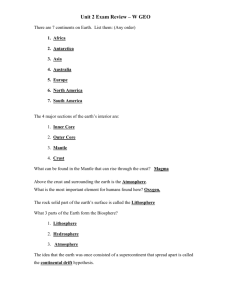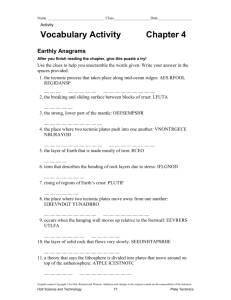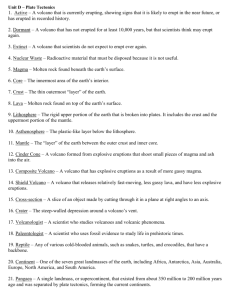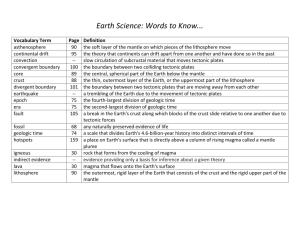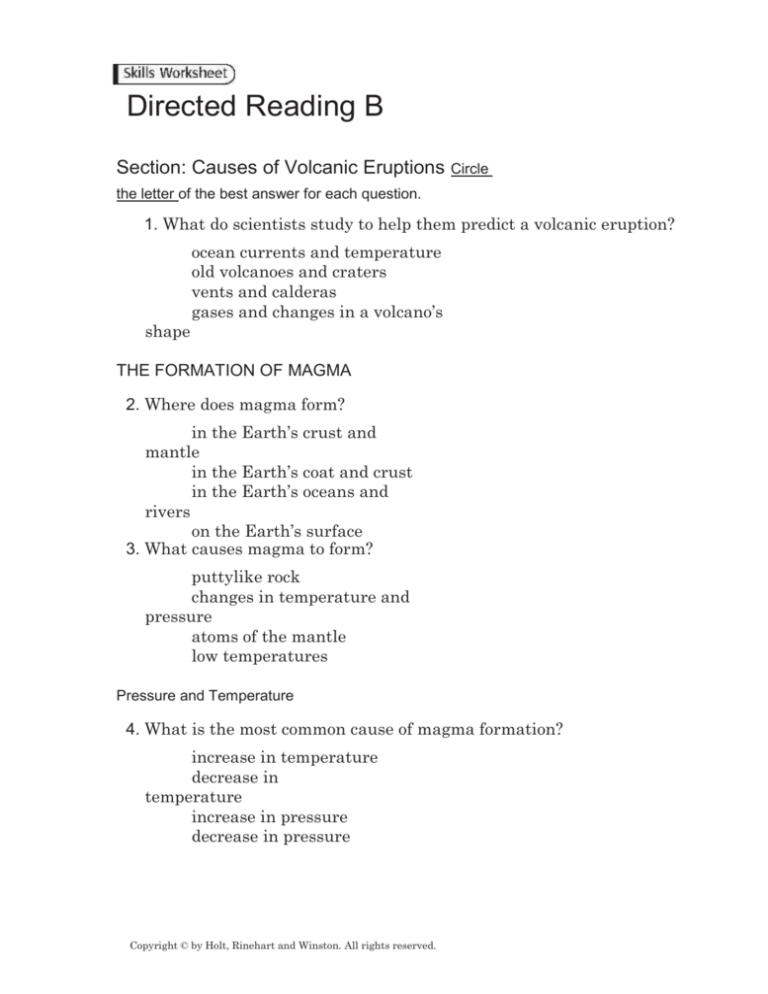
Directed Reading B
Section: Causes of Volcanic Eruptions Circle
the letter of the best answer for each question.
1. What do scientists study to help them predict a volcanic eruption?
ocean currents and temperature
old volcanoes and craters
vents and calderas
gases and changes in a volcano’s
shape
THE FORMATION OF MAGMA
2. Where does magma form?
in the Earth’s crust and
mantle
in the Earth’s coat and crust
in the Earth’s oceans and
rivers
on the Earth’s surface
3. What causes magma to form?
puttylike rock
changes in temperature and
pressure
atoms of the mantle
low temperatures
Pressure and Temperature
4. What is the most common cause of magma formation?
increase in temperature
decrease in
temperature
increase in pressure
decrease in pressure
Copyright © by Holt, Rinehart and Winston. All rights reserved.
Magma Formation in the Mantle Circle the letter of the best
answer for each question.
5. Magma is less dense than the surrounding rock, so the
magma slowly
sinks to the bottom.
rises to the surface.
melts into liquid
rock.
moves to the side.
WHERE VOLCANOES FORM
6. Why are the plate boundaries surrounding the Pacific Ocean
called the Ring of Fire?
There is a huge lava plateau there.
There are many active volcanoes in the
area.
There is a large ring-shaped crater there.
The shallow water is a golden color.
7. Where do most active volcanoes form?
where tectonic plates join
where tectonic plates separate
where tectonic plates collide
where tectonic plates slide past each
other
WHEN TECTONIC PLATES SEPARATE
8. Where do tectonic plates move away from each other?
at a rift zone
at a divergent
boundary
in the mantle rock
in the Earth’s crust
Copyright © by Holt, Rinehart and Winston. All rights reserved.
Circle the letter of the best answer for each question.
9. What is a deep set of cracks between plates called?
a divergent
boundary
a mantle rock
a crater column
a rift zone
10. Why does magma rise to the Earth’s surface?
Magma is heavier than rock.
Magma is less dense than the rock around
it.
Magma is harder than the rock around it.
Magma is tricky.
Mid-Ocean Ridges Form at Divergent Boundaries
11. What is the name of a mountain chain created by lava
from undersea rift zones?
a.divergent
boundary b.tectonic
plate mid-ocean ridge
hot springs
Copyright © by Holt, Rinehart and Winston. All rights reserved.
WHEN TECTONIC PLATES COLLIDE Read the words in the box. Read
the sentences. Fill in each blank with the word or phrase that best completes
the sentence.
mantle plumes subduction hot spot convergent
boundary temperature cracks
12. The place where tectonic plates collide is called
a(n) .
13. The movement of one tectonic plate under another is
called .
Subduction Produces Magma
14. When oceanic crust scrapes under continental crust,
the and pressure increase.
HOT SPOTS
15. A volcanically active place that is far from any plate
boundaries is called a(n) .
16. Some scientists believe that hot spots are places
above
, which are columns of rising magma.
17. Some scientists believe that hot spots form
along in the Earth’s crust.
Copyright © by Holt, Rinehart and Winston. All rights reserved.
PREDICTING VOLCANIC ERUPTIONS Read the description. Then,
draw a line from the dot next to each
description to the matching word.
18. probably won’t erupt again
19. will probably erupt sometime
in the future
20. will probably erupt soon
••
•
a. active volcano b.
dormant volcano
c. extinct volcano
Measuring Small Quakes and Volcanic Gases Circle the
letter of the best answer for each question.
21. What happens just before a volcanic eruption?
The number of small earthquakes increases.
Lava fountains spew out all around the
volcano.
Gases turn to poison.
There is lots of thunder and lightning.
22. What can changes in volcanic gases indicate?
changes in temperature
changes in the magma chamber
below
changes in an earthquake’s intensity
changes in weather
Measuring Slope and Temperature
23. What is a tiltmeter?
an instrument that measures sound
an instrument that measures gases
an instrument that measures earthquakes
an instrument that measures small changes in a
volcano’s slope
Copyright © by Holt, Rinehart and Winston. All rights reserved.

